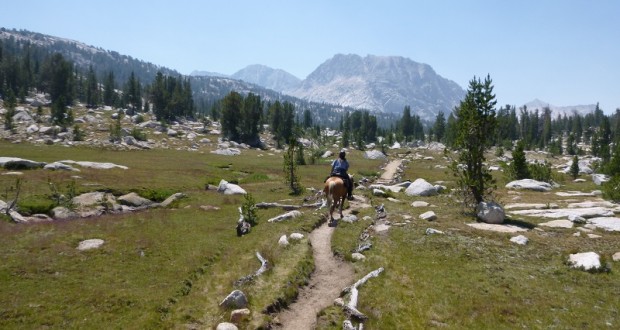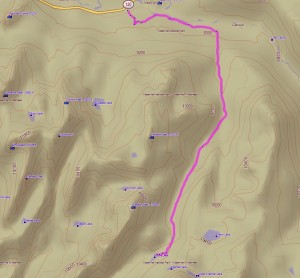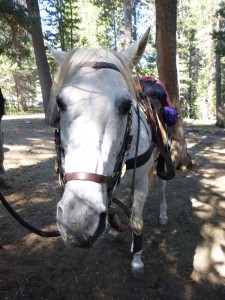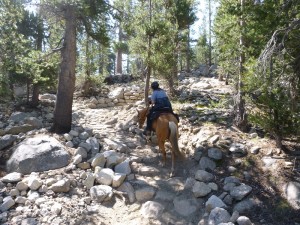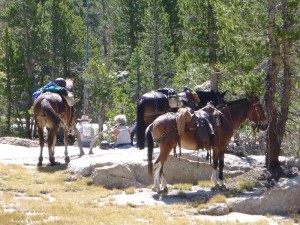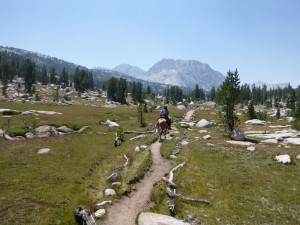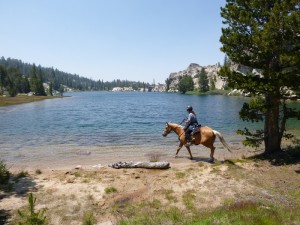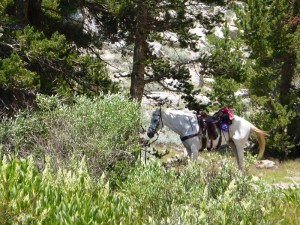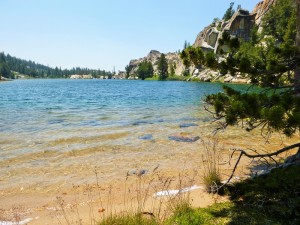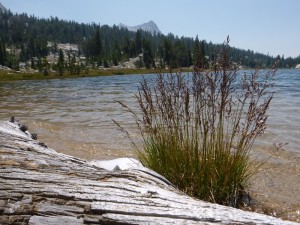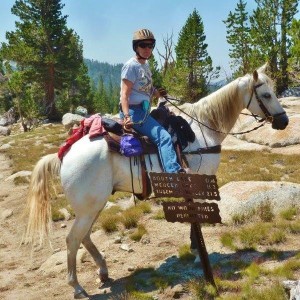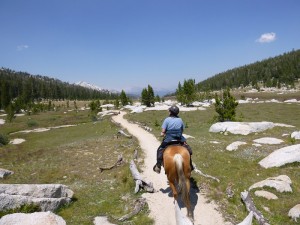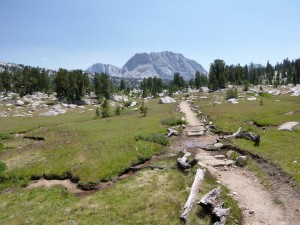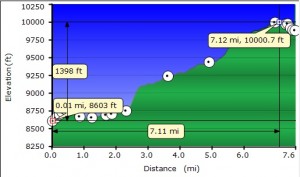Where: Yosemite National Park
Distance: About 15 miles
Difficulty: Moderate
Elevational Range: 7,868′ – 10,000′
Date: July 26, 2015
Highlights: Riding horses in Yosemite’s beautiful high country is always a special treat. Taking them up to the 10,000′ elevation where we had the towering, jagged high points of Vogelsang, Fletcher and Rafferty Peaks along our side as we mosied up the trail to Boothe Lake was extra special. My friends were staying in one of the horse campsites at Tuolumne Meadows and invited me to come up and ride with them. How could I say no to that fabulous invitation? Meet my trusty steed for this day: Buckshot aka Buck.
We headed out of Tuolumne Meadows Horse Camp up the trail along Rafferty Creek, through Tuolumne Pass at 10,000′ then down to beautiful Boothe Lake. The trail was gentle at the beginning, following the Tuolumne River. After we started up the fork in the trail that headed up to Vogelsang, it started gaining elevation on a cobblestone trail.
This was a challenging and tough trail for the horses and we stopped periodically to give them a breather. We came across a group of folks on mules, giving their stock a rest. Buck was not wild about mules and he knew long before we came up on this group that they were there and he told me so.
We headed on up the trail. Smoke from the Willow Fire had made its way into this area. I was hoping that the wind that was predicted to come up in the afternoon would blow it out but that was not to be.
After coming through Tuolumne Pass at 10,000′ elevation, we took the right fork towards Booth Lake and worked our way down to a sandy beach area on the north side of the lake. Boothe Lake is at 9882′ elevation. We tied up the horses, checked out their hooves to make sure they were ok and I gave Buck a carrot.
I was curious about how Boothe Lake got its name so I did a little bit of research. Clyde Dubley Boothe was one of the early Rangers in Yosemite National Park. I tracked him through census, military, military and death records.
- Clyde Dudley Boothe was born June 27, 1891 in Usona, Mariposa County, CA. His father Charles was listed as a farmer/rancher on census and was born in Illinois, his mother Charlotte born in CA.
- 1900: On the census, his name is listed as Dudley Clyde and he was living with his parents and 6 siblings in Township 16, Mariposa County, CA.
- 1910: His name is listed as Clyde D., still living with his parents at the Sierra Forest Reserve, Mariposa County, CA.
- May 30, 1917: Filled out his WWI Draft Registration Card at Yosemite, stating that he lived at Usona, was employed at Yosemite as a Park Ranger. His physical description is that he was tall, medium build, brown eyes and dark hair.
- 1920: On the census, his name is listed as Clyde D., living with his parents at Darrah, Mariposa County, CA and employed as a Ranger for the U.S. Forest.
- October 19, 1920: He married Mildred Palmer in Alameda County, CA. He listed his residence as Yosemite, Mariposa County, CA. Mildred was born in Illinois.
- 1930: On the census, his name is listed as Clyde D., he is married with two children, working as an agent with Catepillar Tractor and living in Modesto, Stanislaus County, CA.
- 1940: On the census, his name is listed as Clyde D. and he is living with his wife and two children in Modesto, Stanislaus County, CA. No occupation is listed but he owns his house.
- About 1942: Clyde Dudley Boothe filled out WWII Draft Registration Card, listing his residence as Modesto, Stanislaus County, CA and occupation as Farm Owner.
- September 4, 1974: Clyde Dudley Boothe passed away in Stanislaus County, CA.
- March 26, 1980: Mildred Rosena Palmer Boothe passed away in Modesto, Stanislaus County, CA.
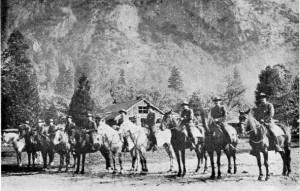
Yosemite Ranger Force 1924—Nelson, Sault, Silva, Bingaman, Rich, Adair, Wegner, Skelton, Boothe, Townsley.
I located a researcher who had located quite alot of interesting information on Clyde boothe, including his obituary in the Modesto Sun Star on Sept 4, 1974.
CLYDE BOOTHE, CATTLEMAN COMMUNITY LEADER, DIES Clyde Dudley Boothe, 83, an early day ranger in Yosemite National Park and Oakdale area cattleman, died this morning in a local hospital after an extended illness. He is survived by his widow, Mildred R. Boothe of Modesto; a son Everett P. Boothe; a daughter, Doris Wanty of Oakdale; a sister Velma Morse of Stockton; six grandchildren and a great grandchild. He was born in Mariposa County in 1891, and had a long career in the outdoors leading to extensive community service in the Modesto area in his later years.
PARK SERVICE Boothe joined the National Park Service in 1915, at the age of 24, after a short job as an assistant US Marshal. He left Yosemite National Park in 1927 after rising to assistant chief ranger. Both of his children were born in the park. Moving to Stanislaus County, Boothe organized a partnership in a Caterpillar Tractor dealership from 1928 to 1937, and began his cattle business in the Oakdale Waterford area. A resident of Modesto, he was president of the Modesto Lions Club in 1928.
CAMP DIRECTOR His interest in the out of doors led to service as a camp director of Camp Bob McBride, Yosemite Area Council, Boy Scouts of American and with Camp Jack Hazard, Stanislaus County YMCA. Several years ago Boothe said, “ My favorite pastime has been working with cattle and horses, and I have had many fishing trips and pack trips in the High Sierra, a great life.” He was a 23 year member of the Memorial Hospitals Association of Stanislaus County board of directors and served as board president from 1956 to 1962, the association’s second president. He was a member of the California Cattlemen’s Association, and pioneered in the planting of Ladino Clover in the Oakdale area. A funeral service will be conducted at 3:30 p.m. Friday at the Franklin & Downs Funeral Home. The family suggests friends make contributions to Memorial Hospitals Foundation, Post Office Box 942, Modesto. Inurnment [sic] will be in Lakewood Memorial Park.
We found a great lunch spot: an old log on that sandy beach on Boothe Lake.
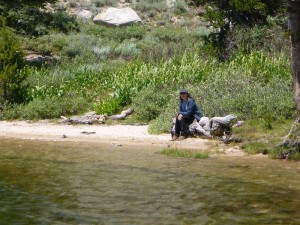
Lunch Spot at Boothe Lake
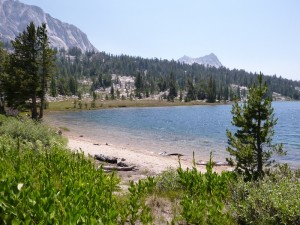
Lunch Spot Boothe Lake
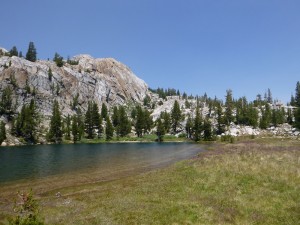
Another view of our Lunch Spot at the Far End of Boothe Lake
And we explored the lake.
Did you know that Boothe Lake was one of the original High Sierra Camps? YosemitePark.com has shared some great history related to the High Sierra Camps as follows:
“In 1923, Superintendent Lewis asked the concessioner to expand the camp system to include sites not accessible by road.
He sent naturalist Carl P. Russell on a Sierra Nevada pack trip to choose sites for five additional camps based on the beauty of their surroundings, spacing from other promising campsites, and the availability of water.
The five original high camps were located at Little Yosemite Valley, Merced Lake, Tenaya Lake, Booth Lake, and Tuolumne Meadows. All of the camps would consist of a mess and cook tent, and dormitory tents for men and women. Attendants and cooks would staff each camp, with equipment and supplies brought in by mule train.
Almost immediately, it became apparent that horseback riders and hikers favored the camps, which soon became known simply as the “High Sierra Camps.”
In 1927, Glen Aulin was created, though it later moved slightly east of its original location due to a mosquito problem. A few years later, the Booth Lake camp was abandoned in favor of Vogelsang, which was established near the junction of the Rafferty Creek and Lyell Fork Trails. In 1940, Vogelsang moved to its current location along the banks of Fletcher Creek. In 1938, the Tenaya Lake camp was closed, and in its place, another was established at May Lake amidst the mountain hemlocks and in the shadow of Mount Hoffman. White Wolf became a part of the High Sierra Camp system in 1951, with Sunrise gaining distinction as the loop’s youngest camp in 1961.”
I didn’t mention that we had the entire lake to ourselves. Sadly, it came time that we needed to head back.
As we headed down, I took one last look back where we came. I just love this area!
I feel that sharing my adventure on this ride would be irresponsible if I didn’t also talk about some of the safety issues that you should be aware of and prepared for if you want to take your horse on a ride such as this.
I am not a high altitude trail riding expert by any means and I would not even think about doing something like this with your horses without alot of preparation and talking with people who have done this. I am fearful that my story and pictures will cause you to load up your horse and head to the Yosemite High country unprepared with terrible consequences.
Not all horses are cut out for riding this trail or in this country. A calm sure footed horse is definately required. You will probably be sharing the trail with hikers, mule trains and other critters. Trails in the mountains can be a big challenge. The trail can have loose spots, straight dropoffs, slick and rocky sections, wet and slippery conditions such as snow and ice.
Horses are also affected by the high altitude, just as people are. When you gain even a few thousand feet in elevation, the oxygen content that you are breathing in the air decreases. Your horse will respond by breathing harder and faster, moving more slowly, and getting fatigued sooner into the ride than normal. It will take time for your horse to acclimate to the high altitude, so before you attempt any dificult ride, some easy ones will help your horse adapt.
Weather is also a big factor to consider. Even with the best plans and forecasts, the unexpected thunderstorm, along with lightening, snow or hail can happen.
For the rules related to stock in Yosemite, follow this link: Yosemite National Park Horseback Riding & Stock Use
You can always leave your horse at home and ride someone else’s. 2 hours and half day rides are available at 3 stables within Yosemite. Here is a link: Yosemite’s Stable Horse and Mule Rides Information on custom pack and saddle trips in Yosemite can be found at this link: Yosemite National Park Pack and Saddle Trips There are 4 Horse Campsites in Tuolumne Meadows and quite a bit of competition for them. For reservations at Yosemite’s 3 Horse Camping Campgrounds (Tuolumne, Bridalveil and Wawona) : (877) 444-6777
Prior Related Blogs: Tuolumne Meadows to Lower Gaylor Lake Horseback Guardians of the Yosemite by John Bingaman Yosemite High Sierra Camp History

